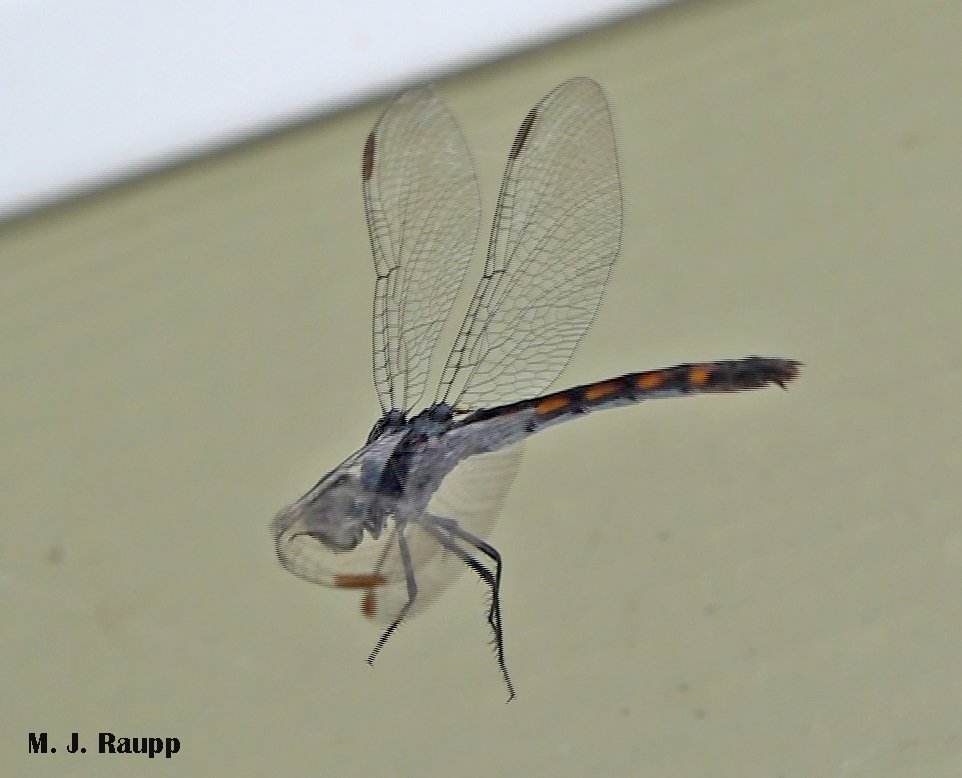
Seaside Dragonlets spend much of their time perching on vegetation and are unique in their ability to breed in salty pools of water near the ocean.
Along the Atlantic coast from Nova Scotia to Florida a delightful small dragonfly called the Seaside Dragonlet makes saline pools its home. This small dragonfly is unique among its kin by virtue of the fact that it is the only member of the order Odonata capable of developing in a marine water source. That’s right, immature stages of other dragonflies live in the fresh water of streams, lakes, ponds, and swamps. Nymphs of the Seaside Dragonlet are able to survive in pools of water with salinities as high as 48%. Now that’s one salty brew.

A large pholcid spider takes advantage of the illuminated porch of a bayside home to construct its deadly web.
Unlike highly active dragonflies intent on staking out territories and actively defending them like ones we met in a previous episode, Seaside Dragonlets are described as lethargic and apparently show little interest in defending territories. Most of their time is spent in the leisurely activity of perching on vegetation with their head directed upwind toward the prevailing breeze. Scientists believe an upwind orientation may assist with lift-off when they decide to fly. On a recent visit to coastal Delaware, we were amazed by the vast number of Seaside Dragonlets in the landscape, where they perched on vegetation and blades of Spartina grasses at the edges of marshy pools. Little did the dragonlets know that humans had unintentionally designed a lethal trap for them in the form of marsh-side vacation homes. In a new development of beautiful homes, builders created covered porticos at the front entry of each house. These small porches were illuminated at night by brilliant lights that attracted a wide variety of arthropods. One group of opportunistic arthropods is spiders, predators with a fondness for building webs in nooks and corners of buildings. In past episodes we met pholcid spiders known as daddy-long-legs, web builders along walls and in corners of rooms inside homes. In the benign corners of the illuminated porch of one vacation home, pholcid spiders discovered excellent hunting grounds and set up shop to capture prey. During summertime, Seaside Dragonlets appear to be a staple in their diet.
On a shrub in the front lawn of a bayside home, Seaside Dragonlets perch facing an onshore breeze. In an upper corner of an illuminated porch, the gossamer web of a pholcid spider has snared a dragonlet. Despite attempts to free itself, by the following morning after a lethal encounter with the spider, it has joined other dragonflies and a crane fly in daddy-long-leg’s web of doom.

Snared by the web of a pholcid spider, a Seaside Dragonlet faces impending doom courtesy of lethal fangs.
Near one such home, dozens of Seaside Dragonlets perched on ornamental shrubs and lazily cruised the landscape. In the corner of the front entryway of this home, several dragonlets and other hapless six-leggers were tangled in the loose web of a rather large pholcid spider. As I entered the home one evening, a newly snared dragonlet struggled to break free of the sticky strands of the spider’s web. By morning, its struggles had ended and the dragonlet joined a macabre tableau of ill-fated prey kissed by the lethal fangs of the spider. As you watch the video, you will see a click beetle and crane fly that also succumbed to the spider’s bite. In addition to some dragonflies, several species of beetles, flies, moths, and other insects are attracted to porch lights. These prey items may catch the attention of hungry dragonflies. In an attempt to capture prey of their own, perhaps Seaside Dragonlets unwittingly become snared in the trap set by an even more fearful predator, the daddy-long-leg spider. There is a strange irony to see a dragonfly, an active ariel predator, dispatched by the clever silken contrivance of the patient spider, abetted by lights and corners provided by humans.
Acknowledgements
Bug of the Week thanks Drs. William Lamp and Jeffery Shultz for providing identifications of the dragonfly and spider, respectively. The following articles were used to prepare this episode: “Observations of dragonflies visiting lights at night” by F. Kon Hong-Qiang, “The Behavior of the Seaside Dragonlet, Erythrodiplax berenice (Odonata: Libellulidae), in a Maine Salt Marsh” by W. Herbert Wilson, Jr., and “Arizona dragonflies” by Ann Cooper.
No comments:
Post a Comment